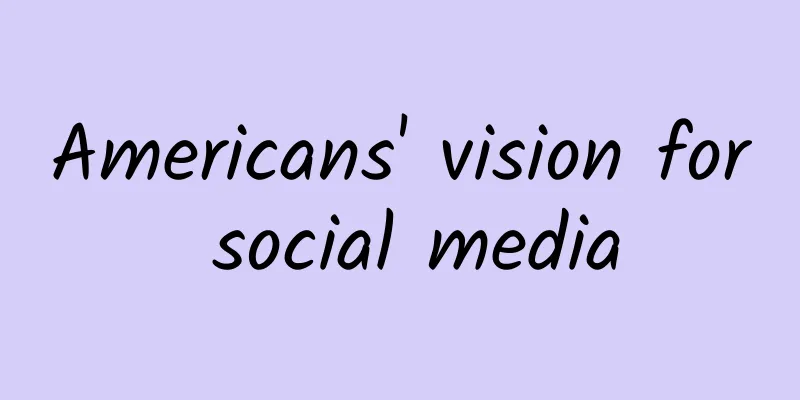Americans' vision for social media

|
From March 6 to 9, 2023, YouGov conducted a questionnaire survey of 1,000 American adult citizens to understand their ideal social media platforms and their views on the settings of various platforms. The survey shows that in Americans' conception of social media, content is pushed in chronological order; users can browse personalized recommended content in their exclusive channels; text and pictures have advantages over audio and video; privacy settings are very important; identity authentication and manual review help ensure a safe network environment; platforms make profits through advertising and e-commerce To understand Americans' vision of social media, YouGov asked respondents to rate their ideal social media, with ratings covering nine dimensions: presentation of content, user verification, notable user verification, privacy settings, content moderation, monetization, content discovery, user engagement, and type of content. The ratings range from "very good" to "very poor." The following are the ideal social media platforms in the eyes of Americans: · The platform presents content in chronological order and in the order in which the posts were published, with the latest posts being presented at the top of the screen. The platform verifies the identity of the user, and the user can choose to use a real name or a pseudonym. Human reviewers are responsible for verifying accounts of well-known people, organizations, and businesses that meet certain criteria. A user's profile is either always private (visible only to selected users) or private by default (visible to all users if desired). Human reviewers will identify and remove content that violates the platform’s terms of service, and users can also report such violations. In terms of profitability, the platform mainly relies on advertising and e-commerce to generate revenue, rather than through subscriptions or selling user data. · Users have a dedicated page to discover new content. This page follows the logic of personalized recommendations, provides trending content, and users can participate in topics through hashtags. · Users can comment, give feedback and share content, join groups, and send private messages to other users. Content presentation While most social media platforms push content through algorithmic mechanisms by default, lawmakers and activists have recently suggested that platforms should be required to give users the option to view content chronologically—in the order in which posts were published. Which method do Americans prefer? The survey showed that respondents prefer chronological order, with 76% of respondents believing that platforms present posts in chronological order "very well" or "somewhat well." User Authentication When it comes to the question of "allowing users to be anonymous" or "requiring users to undergo identity verification," Americans are more inclined to the latter. Most respondents (62%) believe that it is a good idea ("very good" or "somewhat good") for platforms to require users to use their real names and verify their identities. Half of respondents (55%) believe that users should be allowed to use pseudonyms while requiring them to provide some form of identity verification, such as an email address. Another 33% of respondents favor anonymity without the need for identity verification. Privacy Settings Most Americans think it’s a good idea for social media platforms to allow users to set privacy settings on their profiles , meaning only selected users can see that information. 69% of respondents think it’s “very good” or “somewhat good” to always set profiles to private; 68% think setting profiles to private should be the default setting, while allowing users to choose whether to make them public; even fewer respondents (59%) favor the current practice of major social media platforms (including Facebook, Instagram and Twitter), which sets users’ profiles to public by default, while allowing them to choose whether to make them private. Notably, only a quarter of respondents (24%) agree that users’ profiles should always be public to all users. Content review Most Americans believe that it is a good idea for social media platforms to conduct content review. Among them, only one-third of the respondents (33%) agree with the "minimum review" approach, that is, allowing most or all content to remain on the platform interface, regardless of whether they violate the platform's terms of service. So, what type of review system do Americans prefer? 66% of the respondents agree that manual reviewers identify and delete illegal content ; 62% of the respondents believe that users should be encouraged to report illegal content, and then manual reviewers should delete it; about half of the respondents (49%) also believe that it is "very good" or "relatively good" for the platform to use algorithms to automatically identify and delete illegal content. Historically, advertising has made up the majority of social media platforms’ revenue, and Americans generally approve of this. 58% of respondents believe that it is “very good” or “somewhat good” for platforms to make money by displaying ads to users . Only 25% of respondents agree that platforms make money by selling user data to third parties. Some social media platforms (such as Facebook and Pinterest) have opened e-commerce features and allow parent companies to take a cut of goods and services bought and sold on the platform. Americans generally have a positive attitude towards this profit model (60% approve, 22% disapprove). In addition, subscription-based revenue models (i.e. charging users for premium content or features) are less popular (41% approve, 45% disapprove). More than three quarters of the respondents (78%) believe that social media platforms should set up a channel in the user interface for exploring and discovering personalized content. How to personalize this channel? 67% of the respondents believe that content push should keep up with the times and the platform should customize hot topic lists for users; 66% of the respondents agree that personalized recommendations should be provided based on user interests and behaviors; and another 63% of the respondents believe that it is better to participate in topics through tags. Text Translation | Peng Sihan Source: |
<<: Look at the pictures and understand the diagnosis method of cerebral infarction
>>: Omdia: MediaTek surpasses Qualcomm Snapdragon in 5G smartphone market
Recommend
Can I have a baby if I am pregnant with Hepatitis C?
If a pregnant woman develops hepatitis C during p...
What's wrong with dampness?
Recently, many female friends have experienced va...
A guy suffered from dry eyes syndrome after staying up late to watch the World Cup. Are your eyes dry?
Science Fiction Network, December 8 (Xu Mingyang)...
Can the milk come back again?
Some mothers run out of breast milk a few days af...
What causes itchy nipples?
There are many reasons for breast itching. If it ...
The role of fallopian tube embolization
As the pace of work and life continues to acceler...
What is the cultural connotation of the Dragon Boat Festival? What are the special dishes of the Dragon Boat Festival?
The Dragon Boat Festival generally refers to the ...
What does a woman's urethra look like?
The appearance of a woman's urethral opening ...
Can I eat Shouwu during menstruation?
Shouwu is a medicinal food and cannot be taken as...
What is the best way to wash women's underwear?
Female friends must pay attention to protecting t...
Lower abdominal pain towards the end of menstruation
Most women who have had their periods should know...
How to check the cervix dilation
To check how many fingers the cervix is dilated...
Is the IUD the best contraceptive method?
Different contraceptive methods can achieve diffe...
A new study shows that regular blood pressure monitoring can help keep your heart healthy
In recent years, the frequent sudden deaths of yo...









